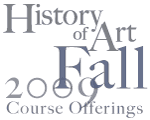771.001
Problems in Art of the 19th Century:
Form, Signification, Interpretation: Art and Culture in Paris, 1848-1894
M 2:30 - 5:30pm
210 Tappan
3 Credit Seminar

This course is concerned with the development of strategies for interpretive readings of pictures within a specific historical context. The context is Paris during the second half of the nineteenth century; the visual materials include painting (Courbet, Manet, Degas, Seurat, Lautrec, et. al.), caricature, political cartoons, photography, and publicity posters; the strategies are derived from art history, narratology, history, and a broad range of methods that loosely coalesce under the rubric "critical theory." The course is designed to assess recent theorizations of Modernism in relation to a wide variety of Parisian cultural phenomena--from the somewhat narrow interests of professional artists, writers, and critics, to the broader consequences of industrialization, urbanization, and the rise of mass culture. It is also designed to encourage new methods of interpretation in order to account for the reconfiguration--characteristic of Modernist painting--of conventional relationships between artist and spectator, between literal and figurative order of signification, between the presumed formal indices of authoriality and their performance as pictorial traces of a "constructed" authorial subject.
Requirements: an oral presentation (@20 minutes) and a research paper (@20 pages).

